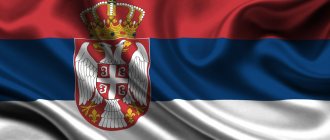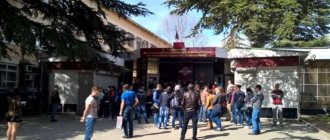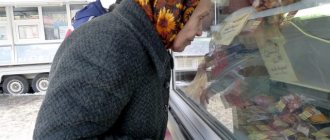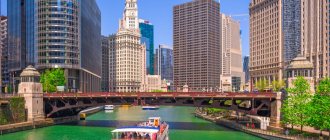The referendum in Crimea and the annexation of the peninsula to Russia influenced the lives of the majority of Russian residents, not only Crimeans. What has changed over the years? Are people living in Crimea better or worse? The magazine Reconomica introduces its readers to an analysis of the situation before and after the referendum, carried out by a young Russian, most of whose relatives live in Crimea. In his article, Ilya provides the opinions of local residents about life on the peninsula, as well as statistics on prices and wages in 2013 and 2018.
Crimea before the referendum
Hello, my name is Ilya, I’m 19 and most of my relatives are residents of the peninsula. Life there turned 180 degrees after the referendum, which directly affected prices, wages and quality of life. In this article, I will probably not stoop to politics, but will simply describe life in Crimea before 2014 and after.
Before the collapse of the Soviet Union
This region has always been important. Back in Soviet times, some of the best resorts and health centers in the Soviet space began to appear there. The peninsula also played a major economic and political role. After all, there are a lot of ports in Crimea that open up space for the fleet to maneuver in the Black Sea. And the Black Sea, in turn, opens the way to the Mediterranean Sea and the Atlantic Ocean. As a result, many coastal cities were very economically developed and prospered.
Yalta in 1970.
“Crimea attracts people primarily with its beautiful beaches, sea, good food and pleasant atmosphere. But it also hides a very large cultural heritage, which attracts visitors even more, who are eager to go on some kind of excursion,” says a resident of Crimea, Anna, who has been living on the peninsula for more than 20 years.
Life within Ukraine
My relatives have lived there for a very long time, since the eighties. Many of them work in the military sector, namely in the aviation sector. Work in the military service has always been well paid, especially in Crimea, since it is a strategically important site and has always been well funded. My maternal aunt has been working in vineyards for more than 15 years (in particularly fruitful years she received 15 thousand hryvnia per season), and in the winter season she works as a seafood seller. In Ukraine, she managed to save up for an apartment and a car, but only because she successfully combined seasonal work.
Article on the topic: Pricing policy in Crimea from the early 90s to the present day. Valuable (priceless) information from a native inhabitant of the peninsula
“Life after the collapse of the Soviet Union began to gradually improve; people who worked honestly and tirelessly managed to earn money for apartments and cars. Many people became private entrepreneurs. But now we have to go through another revolution. Small businesses are “destroyed” by high taxes and bureaucracy, and unemployment and the crisis often force people to live on the brink of poverty,” says Olya, a resident of Crimea.
Crimea in 2013.
Yes, everything there is very much tied to the seasons, which are usually divided into “summer” and “winter”. The winter season begins at the end of September, when the water becomes cold and there are no more customers, and ends at the end of May. During this time, many spend what they managed to earn. My relatives told me how they could earn up to 30 thousand hryvnia per season, which was a lot of money at that time. Prices in Ukraine were approximately the same as in its main part. The only thing that bothered us was the expensive and poor drinking water, as well as slightly inflated prices for some food products. Previously, this was due to the difficulty of delivering food to the peninsula.
Crimea: a year after moving
That year I published an article about moving to Crimea from Perm. It’s difficult to admit your mistakes, I understand that, and that’s why I wanted to debunk the main myths that Russians encounter when studying Crimea. After all, I myself was very much mistaken about him, and when I arrived, I realized how much I was mistaken.
The “Not Sitting” audience reacted ambiguously to the article; there were many tactless questions about housing and work and accusations of almost propaganda. Although, as I already said, I just wanted to debunk the main myths about Crimea.
Sevastopol
Now that my life has more or less settled down, I can tell you about everything in more detail. And I want to start with work.
As I already wrote in the previous review, any specialist can find a job in Crimea: a doctor, an IT specialist, an oil worker, etc. Everything about widespread unemployment and the lives of pensioners is a complete lie.
Life on the peninsula is in full swing, construction is everywhere, hands and minds are needed everywhere. I myself am an accountant by education, I received my second degree as a manager, I started my own business in Crimea, I have an audit firm, we conduct primary audits. Over the course of a couple of years, a small staff appeared; interviews, of course, were conducted by myself. Many worthy candidates came, many from central Russia.
When I worked as an auditor in Perm, I was on errands, I didn’t like it, so I was constantly stressed and wanted to quit everything. As soon as I started working for myself, I immediately became interested, and now I work a lot for two people. I can afford to hire another employee, but as long as I have the strength and desire, I do everything myself.
Since I began to often stay late at work until the night, I decided to look for housing in the city, this time through a realtor friend. The first time I looked at the apartments myself, I didn’t see anything good for an adequate price tag; dead Khrushchev apartments cost from 3-4 million rubles.
This time, with the help of a professional, I found a small studio for only 2 million rubles, 5 minutes walk from the office. Just right for an overnight stay. Of course, I would like an apartment with a sea view, but this is in future plans.
I submitted a request for a mortgage to the three largest banks that operate on the peninsula, they approved all three, and took it where the most favorable interest rate was. It turned out to be 11%. On the mainland, of course, I would get a lower percentage; competition still decides.
Yalta
I never tire of repeating that Crimea is an ideal place for entrepreneurs, those who want to open their own business. Sanctions are of course a minus, but they also have a plus. Big federal players don't interfere here. If you want to open a grocery store, you don’t have to compete with Pyaterochka and Magnit. If you want to open a communication store, there won’t be MTS or Svyaznoy in your neighborhood, etc.
Over the course of the year, I managed to visit many places in Crimea and appreciate its diversity and scope. But I made a certain conclusion for myself: there is no better city on the peninsula than Sevastopol!
In general, I was pleased with the cities of Crimea; they all look quite colorful, presentable and comfortable. I love discovering new things and going to new places.
In the Perm region it was like this, you drive 5 hours along a broken road through the taiga to a neighboring city, there are a couple of places there that you can visit, like the Kungur Ice Cave. And that’s it, no service, it’s good if there are at least a couple of such places in the city.
In Crimea, the road from Sevastopol to Yalta begins with vineyards, then coniferous forests, the sea and incredible mountains that will take your breath away. And all this in 1.5 hours on perfect new roads. There are still places in the cities themselves where the roads have not been repaired, but communication between cities is simply beyond praise.
Yalta is probably the second city after Sevastopol, which I advise those who are thinking about moving to Crimea to take a closer look at. The downside is, of course, the mountainous area, I don’t like it, but the city is very beautiful and developed.
I also really liked Feodosia. Even though we were caught in bad weather, I still really liked the city, it is so small, atmospheric, with historical buildings.
In general, cities and towns are perceived differently in Crimea. If on the mainland of Russia, especially somewhere in the Urals, a village is a complete backwater, a small town is five-story gray panels without history, and a metropolis is an ordinary million-plus population with an airport, shops, work, etc., then in Crimea the priority shifts on the contrary, to small settlements. They live their quiet, measured lives, while they have everything they need for a comfortable life.
Balaclava
As soon as I saw Simferopol, I immediately didn’t like it. I felt like I was in Perm. All the same rusty kiosks on every corner, a lot of ugly 90s-style advertising, cars, dirt, etc. And the people in the central part of Crimea are somehow different, I don’t know what’s the matter, but they seem rude and unkempt to me. In general, I wanted to get out of it as quickly as possible. And now I come less and less, mainly on business. Therefore, I definitely won’t recommend Simferopol for moving. And what's the point?
If you go to Crimea, then first of all for nature, climate, warmth, fresh fruit, peace and tranquility. Even if you work a lot like I do, you can still have time to fully relax.
Life after the referendum
In 2014-2015, the region began to experience greater instability. Since the route with Ukraine was closed and most of the regular tourists stopped coming on vacation. It is worth noting that many Russian residents came to Crimea by train. Since it was cheap and convenient compared to the ferry, which in 2014-2015 was simply in terrible condition.
The Kerch crossing had to be greatly improved, which helped to improve the flow of visitors starting in 2021, when the situation returned to normal. In the spring of 2021, a bridge connecting Crimea with the rest of Russia began operating, which resulted in an increase in tourists and prices in large cities. Because of the crisis, prices for absolutely everything rose sharply, but salaries remained at the same level, they just switched from hryvnia to rubles. This transition was not as painful as, say, in Novorossiya, where rubles and hryvnia were still in circulation for a long time, there were no official exchange offices, etc.
About life in Crimea: How a simple taxi driver was able to buy a private house in Simferopol without a mortgage or debt. Real story
The new government has both supporters and opponents. Although the level of trust in the current government, in spite of everything, is quite high. After all, the residents of Crimea see that things are much worse in Ukraine now than they are, so they are still happy to join.
Same sea, same beaches. Year 2021.
“The Crimean Tatars remained very dissatisfied, they began to be increasingly discriminated against and surrounded by various taxes, as well as to transfer their fertile land under state control. The military, on the contrary, began to receive an order of magnitude higher, and law enforcement officers also began to receive higher wages. In general, state control has sharply increased since 2014,” says Ivan, a private entrepreneur and resident of Crimea.
Crimeans have gone through a very difficult path and now their internal economy is more or less improving thanks to good funding from the state. Also, residents of Crimea are very happy about Russian citizenship. Many of them, having received it, immediately rushed to conquer Moscow and other large cities of Russia.
Prices for goods and services: before and after
The table shows examples of food prices based on Krymstat readings for August 2021, and average prices for the summer of 2013 in Chernomorsk. To make it easier to compare, the price is also given in dollars at the exchange rate for summer 2021 and summer 2013.
| Product name (kg) | Prices for summer 2021 | Prices for summer 2013 | |||
| rubles | dollars ($1=66 rub.) | hryvnia | rubles | dollars ($1=32 rub.) | |
| Beef | 436,73 | 6,6 | 45 | 180 | 5,63 |
| Pork | 325,46 | 4,9 | 40 | 160 | 5 |
| Chicken | 134,64 | 2,04 | 20 | 80 | 2,5 |
| Potato | 71,35 | 1,08 | 4 | 16 | 0,5 |
| Sugar | 41,84 | 0,63 | 8 | 32 | 1 |
| Butter | 548,81 | 8,3 | 50 | 200 | 6,25 |
If we take prices in rubles, they have increased significantly. It is worth noting that the significant increase in food prices is due not only to the transition of Crimea to Russia, but also to the general crisis that overtook both Ukraine and Russia. In addition, prices in dollar terms for many food products not only did not increase, but even became lower.
Salary: before and after
To make the salary level more clear, we will present it in hryvnias and dollars - until 2014, in rubles and dollars - at present. According to the Ministry of Finance of Ukraine, the average salary in Ukraine averaged 3273.83 hryvnia - $400, while in Crimea the average salary was 2877.66 hryvnia - $350.
And more about Crimea: Seasonal earnings in Crimea. Is it possible to earn a living in a couple of months?
For 2021, from January to June, the average salary according to Crimean Statistics is 28,859 rubles. – $440, this is more than in 2013, but it is also worth taking into account the increase in prices for products and services, and also the fact that statistics do not take into account illegal earnings, or those that simply cannot be tracked. For example, spontaneous markets near the beaches in the summer season or the sale of wine.
Between the steppe and the sea
On the map, Simferopol looks like the center of a star with seven rays - that’s how many roads lead to the city from all sides of the peninsula. It fills the valley that was formed by the Salgir River, as well as two ridges of the Crimean mountains - External and Internal. The higher Inner Ridge closes the city from the sea, creating a special microclimate. In a straight line, the Black Sea coast is only 40 kilometers away, but in the city this is not felt at all. It seems that you are in an endless steppe.
You can get from the mainland to Crimea via the Crimean Bridge
The Salgir River flows through the city. With a length of 232 kilometers, it is considered not only the longest, but also the longest river of the Crimean Peninsula. However, almost every year in the summer the current dries up below Simferopol. This indicates a lack of precipitation. Within the city, the tributaries Maly Salgir, Abdalka, Kazanka and Slavyanka flow into the river.
On the southeastern outskirts lies the Simferopol Reservoir. The largest Crimean man-made reservoir was built in 1954. The idea of construction appeared back in 1910. Then a cholera epidemic broke out in Simferopol, and at the same time a colossal shortage of drinking water arose. Research was carried out, but the project was frozen by the First World War. Only in the middle of the century was Salgir blocked with a dam. Now the reservoir is used for urban water supply and land irrigation.
The reservoir is used for urban water supply and land irrigation
Despite the proximity to the sea, the local climate belongs to the foothill dry-steppe type. The long winter lasts from mid-February to mid-May. The summer heat ends at the end of September. Warm autumn ends on New Year's Eve. Winter is short and mild. On average it lasts about a month. In January there are frosts down to -3 degrees, but usually the thermometer does not drop below zero. The average summer temperature is +24 degrees. But forty-degree heat can also happen. There is very little precipitation throughout the year.
Standard of living and prices
The standard of living of Simferopol residents is average and below average, since prices are Moscow and salaries are Crimean.
There are several shopping centers in Simferopol. The largest and most popular shopping centers are Meganom and South Gallery. There are boutiques, grocery stores, cafes, cinemas, etc. On weekends, shopping centers are full and you can barely find a parking space. There are always crowds of people in Auchan. However, in boutiques the selection of clothing leaves much to be desired. Therefore, many Simferopol residents go shopping to Krasnodar, since there is a better choice and more interesting prices.
Trade
Utility expenses
Here we have absolutely ridiculous expenses.
WATER. I don’t pay for water because we have our own well. In general, one cubic meter of water now costs 33.2 rubles in Old Crimea - this is water supply. By the way, in 2021 a cubic meter of water cost 41 rubles, i.e. water has become cheaper. You can also order imported water - if the water supply is broken or there is not enough water, it costs 1,600 rubles per car (5.5 cubic meters), that is, it already works out to 290 rubles per cubic meter.
ELECTRICITY. Starting from the new year, the tariff is 3.04 rubles/kWh (for consumption from 150 to 800 kW per month). For December I paid 495 rubles. (193 kWh), for November—385 rubles. (157 kWh).
GAS. Tariff 4.2 rub./cubic. I paid 1168 rubles for December, 1214 rubles for November, 580 rubles for October, 151 rubles for September. This amount includes heating, hot water, heated floors in the bathroom, and gas stove.
GARBAGE REMOVAL. I pay 54.76 rubles. per month. Once a week, on Thursdays, I put a bag of garbage outside the gate. During the day, a car comes and picks up the trash. The system is quite good, except for one “but” - the dog. They tear the bag and scatter the garbage on the ground. However, I solved this problem in an elegant way - I bought a can of dichlorvos and sprayed it inside and outside the bag. Not a single dog, nor a single cat, comes close to the bag.
INTERNET. Everything here is as it was before - 400 rubles/month for 20 Mbit/sec.
MOBILE. MTS works here, but not Crimean, but Krasnodar. There are no communication shops, but SIM cards are sold in various shops. “SuperMTS” tariff, 100 rubles for connection (of which 50 rubles go to the account), and then you can change the tariff through your personal account and connect additional services.
About moving
Two years ago, on January 19, 2021, I became a Crimean. My wife and I bought a house in the town of Stary Krym and moved here from St. Petersburg for permanent residence. And now I haven’t left the peninsula for exactly two years. I changed my registration from St. Petersburg to the Old Crimean one, registered my car here, replaced my office desk and keyboard with an axe, hammer, shovel and rake.
I'll start with the main thing. A year ago, one person asked me: now that my pink Crimean period is over, I think about my move to Crimea, what has changed and how do I generally live here? Here is my answer, it is in this photo.
It's just a 15 minute drive from my house on the side of the road. And look at the colors of the November sunset! And a panorama of the Karadag ridges on the horizon.
No, my pink period is not over, that’s the thing. I didn’t love Crimea any less. He still fascinates me, so much so that sometimes it takes my breath away with delight. These landscapes with clear lines of mountains on the horizon, lush colors of sunsets and sunrises, salty splashes of the sea in the face, the smell of steppe grasses, blooming almonds, pink tamarisk flowers along the roadsides, the crackling of cicadas, scatterings of bright stars in the night sky.











